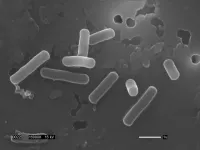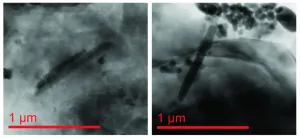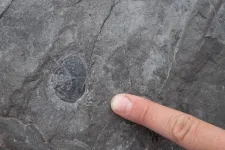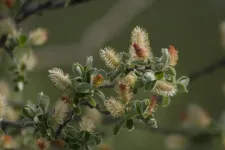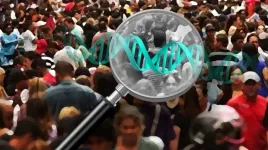(Press-News.org) New research from North Carolina State University reveals that probiotic Lactobacillus bacteria use enzymes situationally to manipulate bile acids and promote their own survival in the gut. These findings further elucidate the complicated relationship between bile acids and gut bacteria and could eventually enable researchers to design lactobacilli with therapeutic properties, thereby engineering a healthier human gut environment.
Bile acids are key players in digestion and overall gut health. Produced in the liver and released after we eat, these acids not only break down cholesterol and help regulate fat absorption, they also have a huge impact on what types of bacteria colonize the gut.
As bile acids move through the gut, they are initially chemically modified through the addition of an amino acid (frequently glycine or taurine), creating a complex "conjugated" bile acid pool. Some gut bacteria have enzymes, called bile salt hydrolases (BSHs), which can cleave or "deconjugate" these amino acids from the bile acids, allowing other bacteria to further transform the bile acids as they continue through the colon. These transformations affect the bile acids' toxicity, which in turn affects the ability of different bacteria to survive in the gut.
"The assumed relationship was that probiotic bacteria like Lactobacillus have BSHs that just deconjugate the bile acid, rendering it less toxic and allowing the bacteria to survive," says Casey Theriot, associate professor of infectious disease at NC State and co-corresponding author of a paper describing the work. "But the reality is a lot more complex - these enzymes are more specific than we thought. Depending on which BSH is there and which bile acid it acts on, you can shape the gut in different ways, making it more or less hospitable to bacteria or pathogens."
"The interplay between bile and bacteria has a huge impact on their ability to live, thrive or die in a very competitive environment," says Rodolphe Barrangou, Todd R. Klaenhammer Distinguished Professor in Probiotics Research at NC State and co-corresponding author of the work. "So we set out to further investigate that relationship."
Theriot, Barrangou, and Matthew Foley, a postdoctoral research scholar at NC State and first author of the paper, did both in vitro and in vivo experiments to determine how and whether BSHs reduced bile acid toxicity. First, they looked at the growth of two strains of Lactobacillus in the presence of different bile acids and were surprised to find that the conjugated glycine or taurine played a big role in determining the toxicity of a given bile acid. The BSHs were then isolated and biochemically studied to determine whether they were more or less active on specific bile salts, and whether they could affect the survival of lactobacilli when grown in the presence of bile acids.
They found that bile acid toxicity was not merely dependent upon whether the bile acid was conjugated or deconjugated by a BSH; rather, the relationships were dependent upon the type of bile acid, the bacteria being acted upon, and which BSH was present.
"When we altered the BSH composition of these Lactobacillus strains, their tolerance of the bile acids and thus their competitive fitness were also altered," Barrangou says. "These BSH enzymes have diverse properties. Bacteria pick up and drop off enzymes regularly - sometimes they pick up enzymes that will help them survive (make bile acid less toxic) or they could pick up an enzyme that will hurt competition.
"So the relationship between bacteria, BSHs and bile acids aren't just one to one. This knowledge could help us strategize ways to improve human health by extending the lifespan of beneficial microbes or preventing the colonization of pathogens."
"If we're going to try and design the gut microbiota in the future, we really have to understand all the players - bacteria, enzymes and bile acids - and their situational relationships." Theriot says. "This work is a big first step in that direction."
"BSHs are just one tool that lactobacilli use to adapt to life inside the competitive intestinal tract." Foley says. "Our future work will further our knowledge of bacterial-modified bile and its consequences for our health."
INFORMATION:
The work appears in Proceedings of the National Academy of Sciences, and was supported by the National Institutes of Health (grant P30 DK034987) and DuPont Nutrition and Health.
-peake-
Note to editors: An abstract follows.
"Lactobacillus Bile Salt Hydrolase Substrate Specificity Governs Bacterial Fitness and Host Colonization"
Authors: Matthew H. Foley, Sarah O'Flaherty, Garrison Allen, Alissa J. Rivera, Allison K. Stewart, Rodolphe Barrangou, Casey M. Theriot, North Carolina State University
Published: Proceedings of the National Academy of Sciences
Abstract:
Primary bile acids (BAs) are a collection of host-synthesized metabolites that shape physiology and metabolism. BAs transit the gastrointestinal (GI) tract and are subjected to a variety of chemical transformations encoded by indigenous bacteria. The resulting microbiota-derived BA pool is a mediator of host-microbiota interactions. Bacterial bile salt hydrolases (BSHs) cleave the conjugated glycine or taurine from BAs, an essential upstream step for the production of deconjugated and secondary BAs. Probiotic lactobacilli harbor a considerable number and diversity of BSHs, however their contribution to Lactobacillus fitness and colonization remains poorly understood. Here, we define and compare the functions of multiple BSHs encoded by Lactobacillus acidophilus and Lactobacillus gasseri. Our genetic and biochemical characterization of lactobacilli BSHs lend to a model of Lactobacillus adaptation to the gut. These findings deviate from previous notions that BSHs generally promote colonization and detoxify bile. Rather, we show that BSH enzymatic preferences and the intrinsic chemical features of various BAs determine the toxicity of these molecules during Lactobacillus growth. BSHs were able to alter the Lactobacillus transcriptome in a BA-dependent manner. Finally, BSHs were able to dictate differences in bacterial competition in vitro and in vivo, defining their impact on BSH-encoding bacteria within the greater GI tract ecosystem. This work emphasizes the importance of considering the enzymatic preferences of BSHs alongside the conjugated/deconjugated BA-bacterial interaction. These results deepen our understanding of the BA-microbiome axis, and provide a framework to engineer lactobacilli with improved bile resistance and use probiotics as BA-altering therapeutics.
Just as plants and animals on land are keenly attuned to the hours of sunlight in the day, life in the oceans follows the rhythms of the day, the seasons and even the moon. A University of Washington study finds the biological light switches that make this possible.
Single-celled organisms in the open ocean use a diverse array of genetic tools to detect light, even in tiny amounts, and respond, according to a study published Feb. 1 in the Proceedings of the National Academy of Sciences.
"If you look in the ocean environment, all these different organisms have this day-night cycle. They are very in tune with each other, even as they get moved around. How do they know when it's day? How do they know when it's night?" said lead ...
There are fossils, found in ancient marine sediments and made up of no more than a few magnetic nanoparticles, that can tell us a whole lot about the climate of the past, especially episodes of abrupt global warming. Now, researchers including doctoral student Courtney Wagner and associate professor Peter Lippert from the University of Utah, have found a way to glean the valuable information in those fossils without having to crush the scarce samples into a fine powder. Their results are published in Proceedings of the National Academy of Sciences.
"It's so fun to be a part of a discovery like this, something that can be used ...
Most snakes get from A to B by bending their bodies into S-shapes and slithering forward headfirst. A few species, however -- found in the deserts of North America, Africa and the Middle East -- have an odder way of getting around. Known as "sidewinders," these snakes lead with their mid-sections instead of their heads, slinking sideways across loose sand.
Scientists took a microscopic look at the skin of sidewinders to see if it plays a role in their unique method of movement. They discovered that sidewinders' bellies are studded with tiny pits and have few, if any, of the tiny spikes found on the bellies of other snakes.
The Proceedings ...
CAMBRIDGE -- The temperature of a planet is linked with the diversity of life that it can support. MIT geologists have now reconstructed a timeline of the Earth's temperature during the early Paleozoic era, between 510 and 440 million years ago -- a pivotal period when animals became abundant in a previously microbe-dominated world.
In a study appearing today in the Proceedings of the National Academy of Sciences, the researchers chart dips and peaks in the global temperature during the early Paleozoic. They report that these temperature variations coincide with the planet's ...
In a new study led by Yale Cancer Center, researchers have discovered a novel metabolic gatekeeper mechanism for leukemia. This mechanism depends on a molecule called PON2, which could lead to a new treatment for the disease. The findings were published online today in the Proceedings of the National Academy of Sciences (PNAS).
B cells are effector cells of the adaptive immune system and are marked by low energy levels, which prevent transformation to leukemia. In this study, Yale scientists identified high expression levels of the detoxifying lactonase ...
Philadelphia, February 1, 2021 - Researchers at Children's Hospital of Philadelphia (CHOP) have demonstrated that autism spectrum disorder (ASD) may be caused by defects in the mitochondria of brain cells. The findings were published online by the Proceedings of the National Academy of Sciences.
Multiple studies have revealed hundreds of mutations associated with autism spectrum disorder, but there is no consensus as to how these genetic changes cause the condition. Biochemical and physiological analyses have suggested that deficiencies in mitochondria, the "batteries" of the cell that produce ...
Scientists have identified a group of drugs that may help stop a leading cause of vision loss after making an unexpected discovery that overturns a fundamental belief about DNA.
The drugs, known as Nucleoside Reverse Transcriptase Inhibitors, or NRTIs, are commonly used to treat HIV. The new discovery suggests that they may be useful against dry macular degeneration as well, even though a virus does not cause that sight-stealing condition.
A review of four different health insurance databases suggests that people taking these drugs have significantly reduced risk of developing dry macular degeneration, a condition that affects ...
A 15-year experiment on Arctic shrubs in Greenland lends new understanding to an enduring ecological puzzle: How do species with similar needs and life histories occur together at large scales while excluding each other at small scales? The answer to this question has important implications for how climate change might shift species' distributions across the globe.
The study was published today in the journal PNAS and led by the University of California, Davis. Its findings also reveal trends related to carbon sequestration and carbon exchange as the Arctic becomes both greener and browner.
EXPANSION AND EXCLUSION
Like lines of traffic traveling the same roads at the same time without crashing into each ...
CLEVELAND - Evidence suggests particulate matter is the air pollutant which poses the greatest threat to global health. Studies have shown that exposure to particulate matter smaller than 2.5 microns is associated with acute and chronic elevations in blood pressure (BP) as well as hypertension. In the study "The Benefits of Intensive Versus Standard Blood Pressure Treatment According to Fine Particulate Matter Air Pollution Exposure" published this week in the journal Hypertension, researchers at University Hospitals (UH) and Case Western Reserve University (CWRU) ...
A paper by a multidisciplinary team of scientists affiliated with various Brazilian institutions, including the University of São Paulo (USP) and the National Cancer Institute (INCA), shows that people of African descent are less likely to find a donor in the National Register of Voluntary Bone Marrow Donors (REDOME) than people with predominantly European ancestry. The paper is published in Frontiers in Immunology.
REDOME is the world’s third-largest bone marrow bank, with more than 5 million registered voluntary donors.
According to the study, having mainly African genetic ancestry can reduce a person’s chances of finding a donor by up to 60%, and having African copies of HLA genes, which must be compatible with ...
